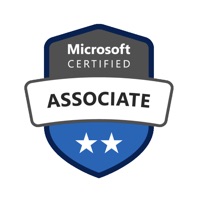
投稿者 投稿者 Naveen Karamchetti
互換性のあるPCアプリまたは代替品を確認してください
| 応用 | ダウンロード | 評価 | 開発者 |
|---|---|---|---|
 Learn Azure AZ-104 Learn Azure AZ-104
|
アプリまたは代替を取得 ↲ | 518 4.76
|
Naveen Karamchetti |
または、以下のガイドに従ってPCで使用します :
PCのバージョンを選択してください:
ソフトウェアのインストール要件:
直接ダウンロードできます。以下からダウンロード:
これで、インストールしたエミュレータアプリケーションを開き、検索バーを探します。 一度それを見つけたら、 Learn Azure AZ-104 を検索バーに入力し、[検索]を押します。 クリック Learn Azure AZ-104アプリケーションアイコン。 のウィンドウ。 Learn Azure AZ-104 - Playストアまたはアプリストアのエミュレータアプリケーションにストアが表示されます。 Installボタンを押して、iPhoneまたはAndroidデバイスのように、アプリケーションのダウンロードが開始されます。 今私達はすべて終わった。
「すべてのアプリ」というアイコンが表示されます。
をクリックすると、インストールされているすべてのアプリケーションを含むページが表示されます。
あなたは アイコン。 それをクリックし、アプリケーションの使用を開始します。
ダウンロード Learn Azure AZ-104 Mac OSの場合 (Apple)
| ダウンロード | 開発者 | レビュー | 評価 |
|---|---|---|---|
| Free Mac OSの場合 | Naveen Karamchetti | 518 | 4.76 |
Microsoft Azure Administrator Manage Azure subscriptions May include but not limited to: Assign administrator permissions; configure cost center quotas and tagging; configure Azure subscription policies at Azure subscription level Analyze resource utilization and consumption May include but not limited to: Configure diagnostic settings on resources; create baseline for resources; create and rest alerts; analyze alerts across subscription; analyze metrics across subscription; create action groups; monitor for unused resources; monitor spend; report on spend; utilize Log Search query functions; view alerts in Log Analytics Manage resource groups May include but not limited to: Use Azure policies for resource groups; configure resource locks; configure resource policies; implement and set tagging on resource groups; move resources across resource groups; remove resource groups Managed role based access control (RBAC) May include but not limited to: Create a custom role, configure access to Azure resources by assigning roles, configure management access to Azure, troubleshoot RBAC, implement RBAC policies, assign RBAC Roles Create and configure storage accounts May include but not limited to: Configure network access to the storage account; create and configure storage account; generate shared access signature; install and use Azure Storage Explorer; manage access keys; monitor activity log by using Log Analytics; implement Azure storage replication Import and export data to Azure May include but not limited to: Create export from Azure job; create import into Azure job; Use Azure Data Box; configure and use Azure blob storage; configure Azure content delivery network (CDN) endpoints Configure Azure files May include but not limited to: Create Azure file share; create Azure File Sync service; create Azure sync group; troubleshoot Azure File Sync Implement Azure backup May include but not limited to: Configure and review backup reports; perform backup operation; create Recovery Services Vault; create and configure backup policy; perform a restore operation Create and configure a VM for Windows and Linux May include but not limited to: Configure high availability; configure monitoring, networking, storage, and virtual machine size; deploy and configure scale sets Automate deployment of VMs May include but not limited to: Modify Azure Resource Manager (ARM) template; configure location of new VMs; configure VHD template; deploy from template; save a deployment as an ARM template; deploy Windows and Linux VMs Manage Azure VM May include but not limited to: Add data discs; add network interfaces; automate configuration management by using PowerShell Desired State Configuration (DSC) and VM Agent by using custom script extensions; manage VM sizes; move VMs from one resource group to another; redeploy VMs Manage VM backups May include but not limited to: Configure VM backup; define backup policies; implement backup policies; perform VM restore; Azure Site Recovery Create connectivity between virtual networks May include but not limited to: Create and configure VNET peering; create and configure VNET to VNET; verify virtual network connectivity; create virtual network gateway
Duolingo-英語/韓国語などのリスニングや英単語の練習
数学検索アプリ-クァンダ Qanda
すぐーる
しまじろうクラブ
Google Classroom
英単語アプリ mikan
PictureThis:撮ったら、判る-1秒植物図鑑
Studyplus(スタディプラス) 日々の学習管理に
CheckMath
英語の友 旺文社リスニングアプリ
運転免許 普通自動車免許 学科試験問題集
ロイロノート・スクール
英語リスニングの神: 英会話 勉強 学習 - RedKiwi
TOEIC®対策ならabceed(エービーシード)
Photomath